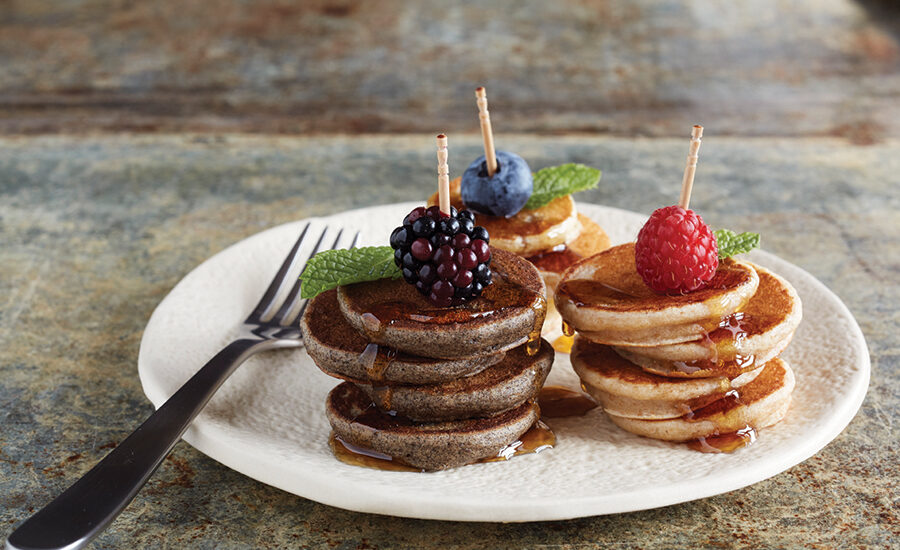Rediscovered Sources of Flour and Starch Entice Product Developers

SOURCE: United Sorghum Checkoff Program (www.simplysorghum.com)

Flours from sorghum, purple barley, millet, quinoa, buckwheat, amaranth, and teff are enjoying a leap in popularity as consumers seek a return to Old World flavors and textures.
SOURCE: Ardent Mills Inc. (www.ardentmills.com)

Banana flour is a high-amylose flour with starch-like functional properties increasing viscosity and gelatinizing at elevated temperatures, depending on the variety.
SOURCE: International Agriculture Group LLC (www.iagnubana.com)

Low-protein, non-GMO native and modified potato starches and flours can fulfill a variety of functions in texture and water retention in gluten-free formulations.
SOURCE: Ingredion Inc. (www.ingredion.com)




The consumer-driven clean-label, plant-based diet, and gluten-free movements call for food ingredients that are easily understood and often reflect cultural heritage and tradition. Thus, the classic “grandma’s” kitchen starch (such as corn starch) and wheat flour are gradually being supplanted or supplemented with other sources of starch and flour.
Starch is a polysaccharide carbohydrate made up of glucose units connected either in a long chain of single or helical strands or in a branched chain. It is the storage form of energy for plants, similar to glycogen, a storage form of energy found primarily in muscle tissue of humans and other mammals.
In food product making, starch typically refers to those polysaccharides that are found in cereal grains, including corn, and potatoes.
Flour generally refers to ground whole grains and seeds. Each starch and flour is unique in its composition, nutritive content (e.g., dietary fiber, minerals, and vitamins). Each also has different functional properties in foods, such as in baked goods and pastries or in coatings and mixes.
The most popular starches used in the food industry are those from corn, wheat, potatoes, and rice. Starches from peas and beans are not as commonly used, but that is changing.
Starch and Flour in Action
Starch is typically used as a thickening agent for sauces, soups, gravies, puddings, pastry fillings, and even salad dressings. Food starches have an extensive history of safe usage and consumption. Despite these versatile applications, their functions within a food matrix are quite variable. These functions typically reflect the nature of the starch chemistry, which is primarily a glucose polymer in the forms of amylose and amylopectin.
These polymers are either linear (amylose) or branched (amylopectin), and thus they differ in their effects, relative to moisture content, environmental temperature, cook time, and food matrix. The structure and content of starches, as well as changes rendered by the aforementioned effects, will ultimately impact the sensory properties, including flavor, texture, and appearance, as well as the stability of the finished product.
Flour, regardless of the source, has many functions in foods. Those functions, as with starch, vary according to the composition of the flour, including presence of gluten in some and protein content in general.
The basic functional properties of flour include water absorption, oil absorption, emulsification (permitting oil and water to mix), foaming and foam stability, and temperature-dependent gelatinization. Flours and flour blends also impart an array of sensory properties to foods.
The internal actions of starches and flours vary widely as well. The digestibility of food starches varies based on differences in their innate molecular structure. For example, resistant starches (such as those found in apples, bananas, potatoes, barley, rice, high-amylose corn, wheat, oats, some tree nuts, and a variety of legumes) are not readily digested by enzymes in the upper gastrointestinal (g.i.) tract. Instead, they are fermented by certain microflora in the lower g.i. tract.
Many experts now classify resistant starches as a form of dietary fiber. Resistant starches have been shown to provide a number of health benefits,
so much so that several years ago the FDA approved a qualified health claim for high-amylose maize resistant starch. The claim suggests that the consumption of this form of resistant starch could help reduce the risk of type 2 diabetes.
This health claim illustrates at least one health benefit of some dietary starches. On the other hand, while most starches are easily broken down in the g.i. tract, this natural process is subject to variations due to differences in the food matrix. The presence of innate substances in some foods can actually inhibit this process.
Old World Favorites
Several emerging heritage grains have made inroads into food processing via their flours and starches. Millet is a group of seed grasses that is naturally gluten-free. Grown primarily in the semiarid tropics of Asia and Africa, this starch-dominant seed is part of the qualified health claim that associates whole grain consumption with a reduced risk of heart disease, type 2 diabetes, and some cancers. (To qualify for such a claim, whole grain must make up at least 51% of the product.)
While its tiny size and crunchy texture have led to millet being used more often as a whole grain, its renewed popularity in America has opened the door to the use of millet flour in formulations, specifically in gluten-free baked goods.
Sorghum is another re-emerging heritage grain attracting interest among product developers lately. While widely consumed in Asia and sub-Saharan Africa for centuries, its use in the US had been restricted largely to animal feed—except in the South, where its molasses-like syrup is almost as common as maple syrup. Its new popularity is rapidly pushing sorghum flour ahead of other non-mainstream competitors.
The nutritional attributes of sorghum are similar to those of corn. The starch characteristics, such as amylose content, vary with the plant cultivar. As with other milled seeds and grains, the functional properties of sorghum starch vary markedly with the drying temperature and other processing conditions.
Sorghum plants require about half the water of corn, but due to difficulties in harvesting (the foliage is very sharp), there is considerable research, especially by the USDA, in using the starch in ethanol production.
When milled with the entire grain, including the hull, sorghum not only is a potential source of protein, but it also adds significant fiber to baked products. The flour has a neutral flavor and light color. This means whole sorghum flour can be used with other flours and subjected to a variety of baking methods.
White sorghum flour, as with traditional flour, is milled from grain without the hull. It too has a neutral flavor and light color and can be used with other flours in a variety of baking methods. Finely milled white sorghum flour is approximately 10% protein, 77% carbohydrate, 12% water, 2% fiber and about 1% fat.
Sorghum is a source of macro- and micronutrients and, when used in flour blends for milled and extruded applications, it contributes to moisture absorption and retention, as well as elasticity, and texture.
Barley flour, like that derived from wheat and rye, contains gluten. However, some research indicates that for certain persons with wheat sensitivities, the gluten forms in barley are tolerated.
Subtle genetic differences among cultivars of these Old World grains can modify their respective functional properties. These functional properties typically reflect variances in amylose/ amylopectin ratios, amino acid/protein profiles, and innate enzyme activities.
New World Sources
Chia seed flour exhibits excellent thickening, emulsifying, and stabilizing properties. In addition, this flour shows good water-holding capacity, oil-holding capacity, viscosity, emulsion activity, and freeze-thaw stability similar to that typically demonstrated by guar gum and gelatin.
Whole chia seed has been gaining popularity in foods and beverages within the US supply chain, but the flour is not widely used as yet.
Quinoa is a highly popular food ingredient and a significant crop in Bolivia, Chile and the plains of central Canada. In these often harsh environments, quinoa is highly tolerant of marginal soils, frost, salinity, and drought.
Often heralded for its higher protein content (about 16%) relative to cereal grains, quinoa flour is limited in numerous amino acids—including branched, aromatic, and sulfurous—particularly those required by infants and children. However, the protein digestibility is around 86%. Quinoa may be blended with legume flours to improve the protein quality.
The free sugars in this seed are dominated by maltose and xylose (about 0.1% each), which provide some unique flavor profiles. However, unprocessed or poorly processed quinoa also contains saponins (typically 1-3%), which are considered toxic glycosides. The typical intake of saponins does not pose a health risk to humans, but early quinoa products released in the US had trace amounts of these glycosides, which have a soapy flavor.
Saponins are naturally found in at least 400 different plant species, including spinach, beets, and asparagus. The combination of selective processing, including more efficient washing and drying, reduces the concentration of saponins and has made quinoa a much friendlier ingredient for product developers.
Teff is a small, gluten-free, hull-less, carbohydrate-rich grain similar to millet in that flour derived from it will contain both the bran and germ. The dietary fiber content is comparable to that of wheat, barley, and rye. This grain, a native cereal crop in Ethiopia, is grown in agriculturally challenging environments, and appears to be naturally resistant to insect pests, including storage pests like weevils.
As domestic consumers seek unique grains, high quality teff is now grown in Idaho. Teff flour is a popular ingredient for injera, which is a spongy, crêpe-like Ethiopian flatbread. As teff flour undergoes post-harvest ripening, amylase activity drops and the versatility of its application in baked goods improves.
Root of the Matter
Cassava (Manihot esculenta) is an edible starchy root that has its origins in South America. It also is known as yuca and manioc. Importantly, cassava can grow in poor quality soils, as noted in various regions of western Africa. While the tuber is gluten-free, it contains several anti-nutrient substances, including cyanide in the form of cyanogenic glycosides, at levels that can exceed 200 ppm.
Because of this, it is important to properly prepare and process cassava so that it is safe for human consumption. Processes such as boiling, baking, and soaking significantly reduce the cyanide levels in cassava, rendering the popular food staple safe to eat. US food manufacturers, benefiting from modern ingredient technology, now have access to reliable sources of safe cassava flour and are taking advantage of this by increasing the product’s usage in many applications.
Not a root but one of the only legumes that grow in the ground, peanuts are seeing their versatility as a food plant extend to increased use of peanut flour. Peanut flour must be made from the roasted nuts, which are then crushed, defatted, and ground into a fine powder. The flour comes in a spectrum of roasts, from light to dark, and the strength of its flavor increases accordingly. Even as a defatted flour, peanut flour still contains between 12% and 28% fat content.
Peanut flour is relatively high in protein (35-50%) although the quality is considered low (PDCAAS ~ 0.52). Despite the potential allergenicity of this ingredient, evidence indicates its functional properties, such as emulsification, stability, and oil and water absorption, are better than those demonstrated by soybean flour.
Peanut flour has a unique flavor profile, and may be used in a variety of gluten-free products. In addition, limited evidence suggests regular peanut consumption (2-3 servings/wk) can help reduce one’s risk of developing heart disease.
Proof is in the Pudding
Tapioca is a starch derived from cassava root. Like many root foods, in addition to seed flour such as from lima beans and flax, tapioca must be appropriately boiled, blanched, or fermented to remove the innate toxic cyanogenic glycosides linamarin and lotaustralin.
The cassava plant synthesizes these toxic substances from the amino acids valine and isoleucine, respectively. This starch is unique in that it is lower in amylose content than many other amylose-containing starches, and the amylose and amylopectin it does contain are of higher molecular weight.
These properties characterize its functionality as a popular thickener and stabilizer without imparting any flavor. Common products utilizing tapioca starch include puddings and baked goods. A particular benefit of tapioca starch is its good solubility in an aqueous matrix. It has high stability in frozen foods as well as those foods that require a moisture barrier, such as commercial pie crusts and baked goods.
Tapioca’s properties also have made it quite popular in gluten-free mixes. “Tapioca is one of the most commonly extracted native starches for use in gluten-free products, either as the main ingredient or as a partial substitute for gluten-free flour,” says Kantha Shelke, PhD, a cereal and food scientist and principal for the food science think tank, Corvus Blue LLC. “This is because of its unique functionalities, especially its pasting behavior, suitable to different applications.”
The pasting behavior of starches affects their properties and how they function in various applications. “Pasting behavior depends on a number of intrinsic and extrinsic factors,” Shelke explains. “These include the source and type of the starch; amylose content and amylose/amylopectin ra-tio; molecular weight; percentage of starch damage; moisture and lipid content; shear rate during mixing and processing; and temperature, among others.”
Since pasting properties govern the firmness of leavened baked items such as bread, Shelke points out that tapioca starch, which has viscosity values comparable to those of corn and wheat starches, produces bread with a similarly soft crumb. But because tapioca lacks the gluten of wheat flour, the cohesiveness of a gluten-free bread made with tapioca flour depends on what other ingredients (such as hydrocolloids and other starches) are present to help hold this delicately soft crumb together with a chewy texture like that of traditional wheat bread.
“A common complaint about gluten-free products is their dry and crumbly texture,” continues Shelke. “Tapioca is capable of absorbing water up to twice its volume, and when the starch grains are swollen, they become very soft and thick—ideal for providing moisture in baked goods and for adding body to thickened gravies and sauces.” Tapioca starch granules swell to twice their size to lend moisture to dense, gluten-free breads.
Tapioca has 15-18% amylose content, which adds the right kind of crispness to pizza or pie crusts without making them hard. “Another reason for tapioca’s popularity is that it is virtually tasteless and odorless,” says Shelke, “and, while white when raw/uncooked, it becomes translucent when cooked and so does not change the appearance of recipes.”
Describing functionality differences between cassava flour and the tapioca starch derived from it, Shelke explains how the starch can help make tender pancakes, while cassava flour—which contains resistant starch—can be used to make crisp and slightly firmer rolls and flatbreads.
The translucency of tapioca and its thickening ability make it ideal as filler in gluten-free berry and fruit fillings for pies and tarts. It is important to point out that tapioca is not nutrient-dense and lacks the fiber and minerals of wheat flour.
Just Add Potatoes
Potato starch has long been a traditional stand-in for grain starches, especially as a substitute for wheat or corn starch. While it cannot readily act as a 100% drop-in replacement for wheat flour in leavened products, it combines very well with other starches and flours to add smooth texture and low water-holding capacity in baked products. These same attributes also make it an excellent component of crunchy coatings for fried and baked foods.
Native potato starch “plays well with others” and makes an especially effective blend with native tapioca starch. The combination can replace modified starches in frozen foods without impacting texture, and the pure white color prevents it from changing the appearance of foods. Moreover, the flavor is neutral, preserving taste integrity in reformulations.
Among the main reasons native potato-tapioca starch blends compare favorably to modified starches is that they have an optimal freeze-heat stability and microwavability. The good viscosity and fine particle size of the blend also improve texture and mouthfeel in finished products versus many modified starches.
The sweet potato’s growing status as a superfood led to its use as a source of flour. Sweet potato flour makes a nutrient-dense alternative flour for snacks, baked goods, and other applications. As a flour designed for health-focused consumers, the product has also benefitted processors by extending shelflife in baked goods.
Off the Tree
Almond consumption has been associated with a decreased risk of heart disease, and almond flour has a long history as a grain-free flour substitute in confections. Almond flour has a unique flavor profile and exhibits many functional properties which vary depending on the particle size and the proportion of non-starch polysaccharides and their respective chemistry.
Almond flour imparts a smooth texture, compared to many seed-derived gluten-free flours that tend to be gritty and coarse. Because of its taste and texture, it is an optimum flour substitute in non-leavened baked products, and works in both sweet and savory dishes.
When almond flour is used in leavened baked applications, such as cakes, breads, and muffins, it will blend easily with other flours. Almond flour helps baked snack products, such as crackers, stay crisp longer, a trait that carries over to its use in coatings for fried foods, especially fish and chicken.
Banana flour is another emerging replacement for flour, starch, or maltodextrin from corn or wheat. A good source of potassium (330mg/30g serving), this high-carbohydrate flour boasts starch-like functional properties that are due, in part, to its approximately 20% amylose content. In general, banana flour can increase product viscosity and even gelatinize at elevated temperatures (74-80˚C), depending on the banana variety.
Native cook-up banana starch is typically made from the fruits in their green stage, before the starches have converted to sugars. It is high in resistant starch, potassium, and magnesium and has a bland, relatively neutral taste. These qualities enable it to be used in a variety of applications. It does not taste like bananas and is not sweet. It is beige to light tan in color.
Green banana flours contain 75-80% amylopectin and only 20-25% amylose. This is similar to the amylopectin/amylose ratio in corn and potatoes. With such long chains of amylopectin, which provides unique viscosifying activity, green banana flour behaves like a lightly cross-linked modified starch.
The flour can maintain that viscosity relatively well and delivers higher final viscosity than other types of starches, with a minimal breakdown after peak. Banana flour can be made available as a pre-gelatinized flour that thickens in cold water and can replace hydrocolloids for stabilizing formulations. It is ideal for applications needing viscosity, adhesion, or water-binding capacity.
Originally appeared in the October, 2017 issue of Prepared Foods as Flour Power.
Looking for a reprint of this article?
From high-res PDFs to custom plaques, order your copy today!









